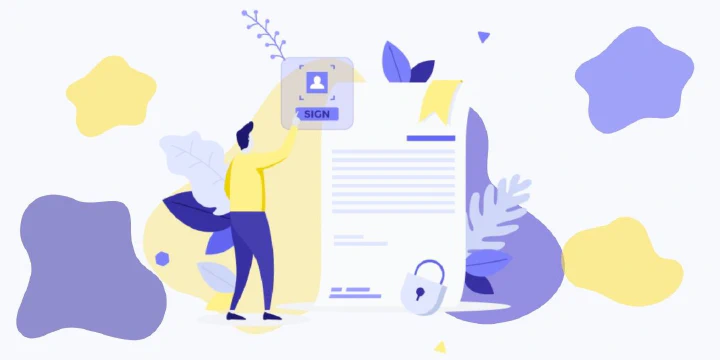Understanding Wet Signatures: Meaning, Importance and Evolution
A wet signature refers to physically signing a paper document by hand with a pen, ink, seal, or other identifying mark. While wet signatures have largely been replaced by electronic signatures, they are still required for specific legal documents and contracts, such as wills, trusts, adoptions, and divorce proceedings, in certain jurisdictions.
- How Wet Signatures Compare to Electronic Signatures
- Environmental and Economic Considerations of Moving from Wet to Electronic Signatures
- Navigating the Legal Landscape: Wet Signatures and the Law
- The Technological Impact on Wet Signatures: Blending Tradition with Innovation
- Practical Tips for Managing Wet Signatures
- Emotional and Cultural Significance of Wet Signatures
- Security Measures and Authenticity Verification for Wet Signatures
- The Future of Wet Signatures in a Digitalizing World

What is a Wet Signature?
Wet signatures were the traditional method of formalizing agreements before the rise of digital alternatives and is still used in specific cases where a physical mark is necessary. It’s called “wet” because the ink needs to dry, unlike digital signatures that are all about clicking a button or tapping on a screen.
In addition to its legal role, a wet signature feels more formal and personal, showing a thoughtful, intentional act. It’s often used in situations that value tradition and personal involvement.
Wet signatures, while personal and authentic, are vulnerable to signature forgery as they can be easily duplicated. Unlike electronic signatures with encryption, wet signatures rely on manual verification, making them less secure in certain contexts.
| Definition | A handwritten (and often stylized) depiction of someone’s name, nickname, or mark on documents. |
| Purpose | Used as a proof of identity and intent on various documents. |
| Types | Can include someone’s name, nickname, simple “X”, or other marks. |
 A wet signature used for an important contract.
A wet signature used for an important contract.
Why Do Wet Signatures Matter?
- Trust and Authenticity: There’s something personal about a wet signature. It carries a sense of authenticity and trust that’s hard to replicate digitally. It’s your unique mark, after all.
- Legal Requirements: In many cases, legal documents, like wills or property deeds, still require a wet signature to be considered valid. It’s a way to ensure that the document has been reviewed and agreed upon in person.
- Security: While digital signatures are secure, wet signatures have their own set of security features — think about the unique quirks of your handwriting that are hard to forge.
How Wet Signatures Compare to Electronic Signatures
Now, you might be thinking, “If wet signatures are so great, why are we all moving towards electronic signatures?” Good question! Let’s break it down.
Wet Signatures vs. Electronic Signatures
- Convenience: Electronic signatures win here. You can sign a document from anywhere in the world, as long as you have internet access. Wet signatures, however, require you to be physically present to put pen to paper.
- Speed: Again, electronic signatures have the upper hand. They can speed up processes by allowing documents to be signed and sent in minutes.
- Environmental Impact: Electronic signatures are more eco-friendly, reducing the need for paper and ink.
So, in the day-to-day digital signatures clearly win. But here’s the thing, even with the rise of electronic signatures, wet signatures haven’t lost their charm. They bring a personal touch to important moments, like signing the deed to your first home or finalizing your marriage certificate. These are moments you might want to remember with something more tangible than a digital click.
A Personal Story: I remember signing the lease for my first apartment. The landlord handed me a pen, and as I signed my name, I felt a mix of excitement and nerves. That physical act of signing was a rite of passage, a moment I could physically feel and remember. It’s something that an electronic signature couldn’t quite capture.
Incorporating Both in Our Lives:
It’s clear that both wet and electronic signatures have their place in our world. It’s not about one replacing the other in every situation but about using each where it makes the most sense. Most of the times, electronic signatures are a blessing. But for those life-changing moments, a wet signature adds a personal touch that digital ones can’t match.
Wet signatures remind us of the personal connections and trust that form the foundation of many of our interactions. As we embrace digital advancements, let’s not forget the value of a personal touch. Whether it’s a wet signature on a cherished document or a handwritten note, these are the moments that truly connect us.
Environmental and Economic Considerations of Moving from Wet to Electronic Signatures
In our journey towards sustainability and efficiency, the shift from wet to electronic signatures offers intriguing environmental and economic benefits. However, understanding the full scope of this transition requires a balanced view of its impacts.
Environmental Benefits
- Reduction in Paper Use: Moving to electronic signatures significantly cuts down on paper consumption, contributing to forest conservation and waste reduction.
- Lower Carbon Footprint: Electronic signatures reduce the need for physical document transportation, thereby lowering carbon emissions associated with mail and courier services.
- Energy Efficiency: Digital processes can be more energy-efficient than their physical counterparts, especially when smart, green technologies are employed.
Economic Impacts
- Cost Savings: Businesses can save considerable amounts on printing, storage, and document handling by adopting electronic signatures.
- Efficiency Gains: The speed and convenience of electronic signatures can lead to faster turnaround times, improving overall business efficiency and customer satisfaction.
- Investment in Technology: Transitioning to electronic signatures requires upfront investment in technology and training. However, the long-term savings and benefits often outweigh these initial costs.
Navigating the Legal Landscape: Wet Signatures and the Law
Navigating the world of legal documents can feel like trying to find your way through a dense forest without a map. But don’t worry, I’m here to be your guide when it comes to understanding where and why wet signatures are legally required.
Why Some Documents Insist on Wet Signatures
Legal documents are all about precision and authenticity. While many countries have embraced electronic signatures for a variety of transactions, wet signatures are still the gold standard for certain documents. This includes major life events like signing a mortgage, creating a last will and testament, or even getting married. The reason? It’s all about ensuring that the document is as secure and tamper-proof as possible.
Or at least, they were the gold standard. After 2020, many institutions realized that the emergency options of signing digitally were in fact reducing the workloads tremendously and continued to allow the for more documents, which previously could only be signed in wet ink.
A Quick Dive into Legal Requirements
The arguments of why wet ink is required can usually be reduced to the following points:
- Authenticity: A wet signature is often seen as a direct reflection of the signer’s intent. It’s hard to argue you didn’t sign something when your unique signature is right there in ink.
- Security: Despite advances in digital security, the physical uniqueness of a wet signature – with its flourishes and pressure points – provides a level of security that’s still highly respected in legal contexts.
- Historical Precedent: Many legal systems are built on centuries of tradition. Wet signatures have a long history of legal recognition, making them a familiar and trusted standard.
Enhancing Security with Digital Signatures
While wet signatures have their merits in terms of authenticity, security, and historical precedent, digital signatures offer distinct advantages that can significantly improve the security of signing documents:
- Enhanced Verification: Digital signatures use cryptographic techniques to verify the signer’s identity, making it much more difficult for forgers to replicate. Each digital signature is unique to the signer and the document, ensuring that any tampering with the document after signing can be detected.
- Audit Trails: Digital signatures come with detailed audit trails, providing a timestamp and record of every action taken on the document. This includes when it was signed, who signed it, and from where, adding an extra layer of security and traceability not available with wet signatures.
- Compliance and Standardization: Digital signatures adhere to international standards such as the eIDAS in the European Union and the UETA and ESIGN Act in the United States, which provide a legal framework ensuring their validity and legal enforceability across borders.
- Access Control and Integrity: Digital signing processes often include robust access control mechanisms, ensuring that only authorized individuals with signature authority can sign or alter documents. This preserves the integrity of the document from creation to final signature and beyond.
By integrating these features, digital signatures not only match the security aspects of wet signatures but, in many cases, surpass them. They offer a modern, efficient, and secure method of ensuring document authenticity and integrity, fitting seamlessly into the digital transformation of legal and business processes.
Understanding Compliance:
Different countries and regions have specific laws about when a wet signature is required versus when an electronic signature will suffice. It’s important to understand these nuances, especially if you’re dealing with international documents or contracts.
The Technological Impact on Wet Signatures: Blending Tradition with Innovation
As we move further into the digital age, it’s fascinating to see how traditional practices like wet signatures still keep their place alongside new technologies. It’s not about leaving the past behind but rather about bringing it with us as we embrace the future.
Innovations Enhancing Wet Signatures
- Digital Pen and Paper: New technologies allow for the capture of wet signatures electronically, blending the authenticity of ink on paper with the convenience of digital storage.
- Signature Verification Software: Advances in software make it easier than ever to verify the authenticity of a wet signature, comparing it against known samples to detect forgeries.
As you can see, there is a way to blend wet signatures and digital ones, it does not always have to be one or the other. For documents without strong legal requirements, Simple Electronic Signatures (SES) can be just a digitized version of your handwritten signature. A wet ink signature, in a digitized format.
Embracing Both Worlds:
The key is not to view digital and traditional methods as opposing forces but rather as complementary elements. For example, a business might use electronic signatures for everyday approvals but reserve wet signatures for major contracts, combining efficiency with the gravitas of tradition.
The journey of the wet signature through the digital age is a testament to our ability to blend tradition with innovation. As we navigate the legal landscapes and technological advancements, we find new ways to honor our past while embracing the future. Wet signatures, with their deep roots in history and personal touch, continue to hold a special place in our digital world, reminding us of the importance of authenticity and human connection.
Practical Tips for Managing Wet Signatures
In the bustling intersection of tradition and technology, managing wet signatures efficiently can seem like a daunting task. But fear not! I’m here to share some practical tips that make handling these signatures a breeze, ensuring they retain their legal and personal significance without causing a logistical headache.
Making Wet Signatures Work for You:
- Organization is Key: Keep physical documents well-organized. Use labeled folders for different categories (e.g., legal, financial, personal) and store them in a secure, accessible location. Consider a fireproof safe for particularly important papers.
- Digital Backups: While the original wet signature holds significant value, having a digital copy can be a lifesaver. Scan or photograph signed documents to create digital backups, storing them securely online or on an external drive. It should be good practice to keep a digital copy of each and every hand-signed document.
- Use Certified Mail or Couriers: When sending documents that require wet signatures, using certified mail or a reputable courier service adds an extra layer of security and traceability.
- Notarization for Added Authenticity: For documents where authenticity is paramount, consider getting signatures notarized. A notary public can provide an official stamp, adding another level of verification.
Real-Life Example
Imagine you’re closing on a house. The excitement is palpable, but so is the mountain of paperwork awaiting your signature. By organizing documents into clear categories (e.g., mortgage, title, inspections), using digital backups for extra security, and ensuring crucial documents are notarized, you turn what could be a chaotic process into a smooth, memorable experience.
Just make sure to digitize all paperwork you choose to sign by hand. While you may want to sign the crucial handover document by hand, consider digital signatures for the rest. The one big signature will be the memory you hold dear in your heart, while the rest will be neatly organized on your hard drives.
Emotional and Cultural Significance of Wet Signatures
Beyond the ink and paper, wet signatures carry a profound emotional and cultural weight. They’re more than just a legal necessity; they’re a bridge connecting us to countless moments of joy, achievement, and commitment throughout our lives.
The Personal Touch
- Moments to Remember: From signing the lease on your first apartment to finalizing adoption papers, these signatures represent pivotal moments in our lives. They’re tangible reminders of our decisions, commitments, and milestones.
- The Art of Signature: In many cultures, the act of signing one’s name is imbued with personal and artistic significance. The style of one’s signature can reflect personality, status, and individuality.
Cultural Perspectives:
- East vs. West: In some Eastern cultures, the traditional seal or stamp (such as the Japanese hanko or Chinese chop) holds a similar significance to wet signatures in Western contexts, serving as a personal and legal mark of authenticity.
- Tradition Meets Modernity: Across the world, the integration of digital processes challenges traditional practices, leading to a fascinating blend of old and new. For instance, some businesses in Japan are moving towards electronic recognition of the hanko, merging centuries-old tradition with modern efficiency.
Embracing the Significance
Acknowledging the emotional and cultural significance of wet signatures allows us to appreciate them not just as legal formalities but as important elements of human expression and connection. Whether it’s the pride in signing a piece of art, the joy of closing on a home, or the solemnity of signing a legal document, these moments are a reminder of the power of our mark on the world.
As we navigate the complexities of the digital age, wet signatures remain a powerful symbol of authenticity, commitment, and personal expression. By managing them with care and understanding their deeper significance, we honor both their practical importance and their place in our shared human story.
Security Measures and Authenticity Verification for Wet Signatures
In a world where security breaches and identity theft are all too common, ensuring the authenticity and security of wet signatures is paramount. Here’s how to protect these vital symbols of consent and agreement, keeping them safe from forgery and misuse.
Enhancing Security for Wet Signatures
- Verification Techniques: Employ advanced techniques to verify the authenticity of wet signatures. This includes comparing signatures to known samples, examining signature dynamics such as pressure and speed, and using forensic methods in critical situations.
- Use of Watermarked Paper: For documents of high importance, using watermarked paper can add an extra layer of security. Watermarks are difficult to replicate, making the document more secure against forgery.
- Incorporate Witness Signatures: Having a third party witness the signing process and add their signature can significantly enhance the document’s credibility and deter fraudulent activity.
A Story of Vigilance: Consider the case of a business owner finalizing a partnership agreement. By insisting on watermarked paper for the contract, verifying signatures against known samples, and including a trusted advisor as a witness, the owner not only secures the agreement but also sets a standard for how seriously the business takes security and authenticity.
In many use cases these measures seem extreme and not necessary, given the fact that electronic signatures already have ways to achieve the same level of security while being much easier to apply.
Simplifying Processes with Advanced Electronic Signature Measures
In addition to enhancing the security of traditional wet signatures, incorporating advanced electronic signature measures, such as Qualified Electronic Signatures (QES), can simplify the signing process while keeping security a top priority:
- Qualified Electronic Signatures (QES): QES are a type of advanced electronic signature that offers the highest level of security and legal recognition. They are created using a secure signature creation device and are based on a qualified certificate for electronic signatures. This ensures the identity of the signer and the integrity of the signed document.
- Biometric Verification: Some advanced electronic signatures incorporate biometric data, such as fingerprint scans or facial recognition, to authenticate the signer’s identity. This adds a layer of security that is unique to the individual and difficult to forge.
- Timestamping and Encryption: Advanced electronic signatures often include secure timestamping and encryption measures. This ensures that the document cannot be tampered with and that the exact time of signing is recorded, providing an immutable record of the transaction.
- Cross-Border Recognition: By adhering to international standards and regulations, such as eIDAS in Europe, advanced electronic signature measures like QES are recognized and legally binding across multiple jurisdictions. This simplifies the process for international transactions and contracts.
By leveraging these advanced electronic signature measures, businesses and individuals can enjoy a signing process that is not only simpler and faster but also offers enhanced security and legal compliance. This represents a significant step forward in the digitalization of secure document signing processes, ensuring that security remains at the forefront of technological advancements.
The Future of Wet Signatures in a Digitalizing World
As digital transformation accelerates, the future of wet signatures becomes a topic of much speculation and debate. Will they become obsolete, or will they continue to hold their ground as a testament to tradition and personal touch?
Balancing Tradition and Innovation
- Hybrid Approaches: The future likely holds a blend of traditional and digital methods. Wet signatures may be reserved for particularly significant or ceremonial documents, while everyday transactions move increasingly online.
- Technological Enhancements: Technologies like blockchain could offer new ways to secure wet signatures, by creating tamper-proof digital records of the signed document.
- Cultural Shifts: As societies continue to digitize, the sentimental and cultural value of wet signatures may evolve, potentially leading to a renaissance in personal handwriting and signature artistry as a counterbalance to digital anonymity.
A Vision for the Future
Imagine a future where signing a document with a wet signature is a choice that reflects the significance of the occasion. In this world, the act of signing becomes a ceremonial moment, enhanced by technology to ensure security and authenticity, while preserving the personal connection that comes from putting pen to paper.
The journey of wet signatures through the digital age is a fascinating reflection of our society’s values, balancing the efficiency and convenience of technology with the authenticity and trust inherent in personal touch. As we look to the future, it’s clear that wet signatures will continue to play a crucial role, evolving alongside technological advancements while remaining a deeply human way to affirm our decisions and commitments.
Please keep in mind that none of the content on our blog should be considered legal advice. We understand the complexities and nuances of legal matters, and as much as we strive to ensure our information is accurate and useful, it cannot replace the personalized advice of a qualified legal professional.

Table of contents
- How Wet Signatures Compare to Electronic Signatures
- Environmental and Economic Considerations of Moving from Wet to Electronic Signatures
- Navigating the Legal Landscape: Wet Signatures and the Law
- The Technological Impact on Wet Signatures: Blending Tradition with Innovation
- Practical Tips for Managing Wet Signatures
- Emotional and Cultural Significance of Wet Signatures
- Security Measures and Authenticity Verification for Wet Signatures
- The Future of Wet Signatures in a Digitalizing World
Want product news and updates? Sign up for our newsletter.
Other posts in Electronic-Signature

Signature Forgery Explained - Types, Risks, and Protection Tips
Signature forgery is the unauthorized imitation or duplication of a person’s signature to commit illegal …

Authority Signatory - Who, Why, & How to Authorize?
An authority signatory is someone in a company who has the official and legal power to sign documents, approve …

How to Add Signature to Email (Gmail, Outlook, and Mail)?
You can easily add a digital signature to your emails on platforms like Gmail, Outlook, and Apple Mail by …
Contracts can be enjoyable. Get started with fynk today.
Companies using fynk's contract management software get work done faster than ever before. Ready to give valuable time back to your team?
Schedule demo

